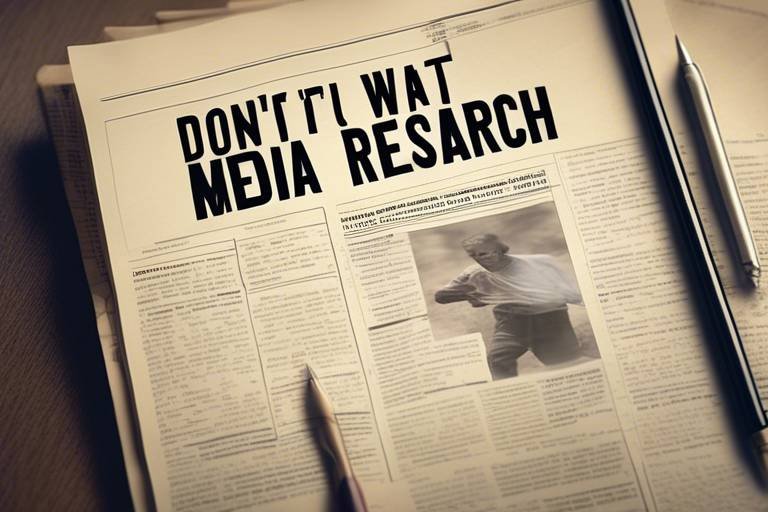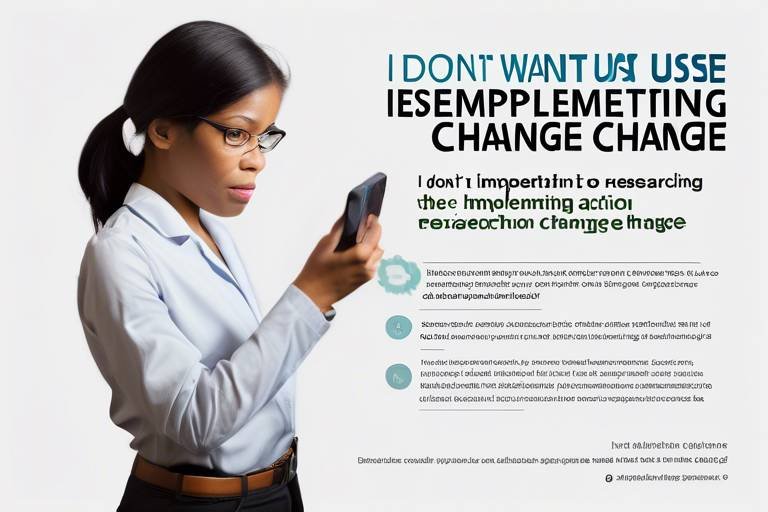The Science of Focus Groups - Best Practices and Innovations
Focus groups have become an essential tool in the realm of qualitative research, allowing researchers to tap into the collective wisdom of a group. They offer a unique platform where participants can share their thoughts, feelings, and experiences on various topics, providing insights that quantitative methods might overlook. But what exactly makes focus groups so powerful? It's all about the interaction and dynamics among participants, which can lead to surprising revelations and deeper understanding.
At their core, focus groups serve multiple purposes. They can help organizations gauge consumer reactions to products, explore public attitudes towards social issues, or even assess the efficacy of marketing strategies. The richness of the data collected during these sessions can be invaluable, offering a nuanced perspective that numbers alone cannot provide. Think of focus groups as a treasure chest of insights, where each participant adds a unique gem to the overall understanding of the topic at hand.
However, the effectiveness of focus groups hinges on a well-structured approach. This includes everything from selecting the right participants to crafting insightful discussion guides. It’s a meticulous process, but when done correctly, the outcomes can be nothing short of enlightening. In this article, we will explore the best practices for conducting focus groups and delve into innovative techniques that can enhance their effectiveness. Whether you’re a seasoned researcher or a novice looking to gather insights, understanding the science behind focus groups is crucial for unlocking their full potential.
As we navigate through the intricacies of focus group methodology, we will highlight the significance of participant selection, the importance of group dynamics, and the innovative tools that can elevate discussions. By the end of this article, you will not only grasp the foundational elements of focus groups but also be equipped with cutting-edge strategies to conduct them effectively. So, let’s dive into the fascinating world of focus groups and discover how they can transform your research efforts!
- What is the main purpose of a focus group? Focus groups are designed to gather qualitative insights from participants regarding their opinions, beliefs, and experiences related to a specific topic.
- How many participants should be in a focus group? Typically, focus groups consist of 6-10 participants to ensure a diverse range of opinions while allowing for manageable discussions.
- What are some common challenges faced during focus group sessions? Challenges can include dominant participants overshadowing others, off-topic discussions, and difficulties in managing group dynamics.
- Can focus groups be conducted online? Yes, digital focus groups have become increasingly popular, especially in remote settings, allowing for broader participation across geographical boundaries.

Understanding Focus Groups
Focus groups are an essential qualitative research method that allows researchers to gather a wide array of opinions and insights on specific topics. Imagine sitting in a room filled with diverse individuals, each bringing their unique perspectives and experiences to the table. This dynamic environment fosters rich discussions that can reveal underlying motivations, preferences, and attitudes that might not surface through traditional surveys or interviews. The primary purpose of focus groups is to explore how people think and feel about a particular issue, product, or service, making them invaluable in fields like marketing, social science, and product development.
So, how do focus groups fit into the broader research landscape? They serve as a bridge between qualitative and quantitative research methods. While quantitative research provides numerical data that can indicate trends and correlations, focus groups delve deeper into the 'why' behind those numbers. For instance, if a survey shows that 70% of consumers prefer a certain product, a focus group can help uncover the reasons behind that preference, revealing insights such as emotional connections or specific features that resonate with users.
In essence, focus groups are not just about gathering opinions; they are about creating a space for dialogue. Participants are encouraged to interact with one another, sparking discussions that can lead to unexpected insights. This organic flow of conversation can sometimes bring out ideas that even the facilitator had not considered. Additionally, focus groups can be tailored to suit various research objectives, whether it's testing a new product concept, exploring customer satisfaction, or understanding social attitudes.
To effectively utilize focus groups, researchers must understand their structure and function. Typically, a focus group consists of 6 to 10 participants, guided by a moderator who facilitates the discussion. The moderator's role is crucial; they must create a comfortable atmosphere that encourages open dialogue while also steering the conversation to ensure all relevant topics are covered. The discussions are often recorded and transcribed for analysis, allowing researchers to sift through the dialogue for key themes and insights.
In summary, focus groups are a powerful tool in the research arsenal, providing a platform for rich, qualitative insights that can inform decision-making and strategy. They are not just about collecting data; they are about understanding the nuances of human behavior and preferences. As we delve deeper into the design and execution of focus groups, the importance of careful planning and innovative approaches will become even clearer.

Designing Effective Focus Groups
When it comes to , the process is akin to crafting a fine dish; every ingredient matters. The design phase is crucial for ensuring that the focus group yields valuable insights. It involves several key elements that, when executed correctly, can transform a simple discussion into a treasure trove of information. One of the first steps in this journey is participant selection. Choosing the right participants is essential for obtaining relevant insights, as they serve as the voice of your target audience. Think of them as the main characters in your story—without them, the narrative falls flat.
In selecting participants, consider a variety of criteria such as demographics, experience, and diversity in group composition. A well-rounded group can provide a multitude of perspectives, enriching the discussion. For instance, if you're researching a new product, you might want to include a mix of age groups, genders, and backgrounds to capture a wide array of opinions. This diversity can lead to unexpected insights and help identify potential gaps in your understanding of the subject.
Once you have a clear understanding of the types of participants you need, the next step is to implement effective recruitment strategies. This is where the magic begins! Utilizing various methods can significantly impact focus group outcomes. You might consider:
- Online platforms like social media and survey sites to reach a broader audience.
- Community outreach programs to connect with specific demographics.
- Offering incentives such as gift cards or discounts, which can motivate potential participants to join.
However, it’s essential to strike a balance in group dynamics. Understanding how different personalities interact can make or break your focus group. Facilitators play a pivotal role here; they must be adept at managing dominant voices while ensuring quieter participants feel comfortable contributing. Think of the facilitator as a conductor of an orchestra, ensuring that every instrument is heard and harmonized.
Group dynamics can be tricky; you want to foster an environment where everyone feels empowered to share their thoughts. This means being vigilant about group interactions and being prepared to intervene if necessary. Techniques such as round-robin discussions or using icebreakers can help create a more inclusive atmosphere. The goal is to ensure that all voices are heard, leading to a richer, more comprehensive discussion.
Another critical aspect of focus group design is the discussion guide. A well-structured guide acts as a roadmap for the discussion, ensuring that you cover all necessary topics while allowing for organic conversation. Crafting open-ended questions is key to promoting in-depth discussions. Instead of asking, "Do you like this product?" try rephrasing it to "What are your thoughts about the features of this product?" This encourages participants to elaborate on their opinions, providing richer data for analysis.
In summary, designing effective focus groups requires careful consideration of participant selection, recruitment strategies, group dynamics, and discussion guide development. Each of these elements plays a vital role in creating an environment conducive to open dialogue and insightful feedback. By investing time and effort into these aspects, you can ensure that your focus group not only meets but exceeds your research objectives.

Participant Selection
When it comes to focus groups, the selection of participants is not just a step in the process; it's the backbone of effective research. Imagine trying to assemble a jigsaw puzzle without knowing what the final picture looks like—if your participants don't represent the diverse perspectives you aim to capture, your findings could be as fragmented as that puzzle. The right mix of individuals can lead to richer discussions and more insightful outcomes.
First and foremost, you need to consider the demographics of your target audience. This includes age, gender, ethnicity, and socio-economic status, which can all influence opinions and experiences related to your research topic. However, demographics are just the tip of the iceberg. You should also take into account the experience and knowledge of potential participants. For instance, if you're researching a new tech product, including both tech-savvy individuals and those who are less familiar with technology can provide a broader range of insights.
Moreover, diversity is key. A homogenous group may lead to groupthink, where participants conform to dominant ideas rather than sharing their unique perspectives. To avoid this, aim for a mix of backgrounds, experiences, and viewpoints. This diversity can spark engaging conversations and uncover insights that you might not have anticipated. Consider using criteria like:
- Geographical location
- Professional background
- Personal experiences related to the topic
Another crucial aspect is the size of the group. While it might be tempting to invite as many people as possible, smaller groups—typically between 6 to 10 participants—are often more effective. This size allows for meaningful interactions while ensuring that everyone has a chance to contribute. Larger groups can lead to quieter participants being overshadowed by more dominant voices, which can skew the data.
In summary, participant selection is a blend of art and science. It requires careful consideration of demographics, diversity, and group size to create an environment where rich discussions can flourish. By focusing on these elements, you set the stage for a successful focus group that yields valuable insights.

Recruitment Strategies
Recruiting the right participants for focus groups is a fundamental step that can make or break your research outcomes. Think of it like assembling a team for a sports match; each player needs to bring their unique skills and perspectives to the game. The goal is to gather a diverse array of opinions that truly reflect the target audience. So, how do you go about this? Here are some effective recruitment strategies to consider:
First and foremost, leveraging online platforms can significantly expand your reach. Websites like social media, forums, and specialized recruitment sites allow you to target specific demographics with ease. For example, if you're looking to gather insights from young adults, platforms like Instagram or TikTok can be incredibly effective. Additionally, you could use community outreach to connect with local organizations, schools, or clubs that align with your target demographic. This not only helps in recruiting participants but also fosters a sense of community involvement.
Another strategy to enhance participation is to offer incentives. Who doesn't love a little extra motivation? Whether it's a gift card, a discount on future services, or even a small cash payment, incentives can significantly boost response rates. Just make sure that the incentives are appealing enough to entice potential participants without skewing the data collected. After all, you want genuine feedback, not just participants looking for a quick buck!
Understanding the importance of diversity in your participant selection cannot be overstated. A homogeneous group may lead to biased results, while a diverse group can provide a richer tapestry of insights. When recruiting, consider various factors such as age, gender, ethnicity, and socio-economic background. This diversity not only enriches the discussion but also ensures that different perspectives are represented, leading to more comprehensive findings.
To sum it up, effective recruitment strategies are about casting a wide net while ensuring that you reel in the right fish. By utilizing online platforms, engaging in community outreach, offering incentives, and prioritizing diversity, you can create a focus group that is not only representative but also engaging. Remember, the quality of your focus group discussions hinges on the participants you select, so invest the time and effort necessary to get it right!
- What is a focus group? A focus group is a qualitative research method that gathers diverse opinions on specific topics through guided discussions among selected participants.
- How do I select participants for my focus group? Participants should be selected based on criteria such as demographics, experience, and the need for diversity to ensure a wide range of insights.
- What incentives can I offer to participants? Incentives can include gift cards, discounts, cash payments, or other rewards that motivate individuals to participate without compromising the integrity of the data.
- How can I ensure a balanced discussion in my focus group? To balance group dynamics, use facilitation techniques to encourage quieter participants to share their thoughts while managing dominant voices effectively.

Balancing Group Dynamics
When it comes to focus groups, balancing group dynamics is like being a conductor of an orchestra. Each participant plays a unique instrument, and it’s your job to ensure they harmonize rather than drown each other out. A successful focus group thrives on the diversity of thoughts and opinions, but this can lead to challenges if not managed properly. One of the most common issues is the presence of dominant voices that can overshadow quieter participants. Have you ever been in a conversation where one person just won’t let anyone else speak? It’s frustrating, right? In a focus group, this can skew the data and lead to insights that don’t represent the full spectrum of opinions.
To foster a balanced discussion, it’s essential to create an environment where everyone feels comfortable sharing their thoughts. You can achieve this by setting clear ground rules at the beginning of the session. For instance, you might encourage participants to be respectful and give each other space to speak. Additionally, using techniques such as round-robin participation can help ensure that everyone has a chance to contribute. Think of it like passing a talking stick around the circle; it gives everyone an equal opportunity to voice their opinions.
Moreover, as a facilitator, you should be observant and ready to intervene when necessary. If you notice that one participant is dominating the conversation, gently redirect the discussion by asking quieter members for their input. This not only enriches the conversation but also makes those participants feel valued. It’s important to remember that the goal is to capture a wide range of perspectives, so don’t hesitate to tap into the quieter voices in the room.
Another effective strategy for balancing dynamics is to mix up the seating arrangements. For example, placing dominant speakers next to quieter participants can encourage more interaction. This arrangement can create a natural flow of conversation, allowing for a more balanced exchange of ideas.
In summary, balancing group dynamics in focus groups is crucial for obtaining rich and diverse insights. By fostering an inclusive environment, setting ground rules, and being proactive in managing discussions, facilitators can ensure that all voices are heard. Remember, a well-orchestrated focus group can lead to groundbreaking insights that might just be the key to unlocking your research goals.
- What are the main challenges in managing focus group dynamics?
Managing dominant voices, encouraging quieter participants, and maintaining a respectful environment can all pose challenges. - How can I ensure all participants feel comfortable sharing their opinions?
Setting clear ground rules, using techniques like round-robin participation, and creating a welcoming atmosphere can help. - What should I do if a participant is monopolizing the conversation?
Gently redirect the discussion by inviting other participants to share their thoughts, ensuring everyone has a chance to contribute.

Discussion Guide Development
Creating a well-structured discussion guide is crucial for the success of focus groups. Think of the discussion guide as your roadmap; it helps navigate the conversation and ensures that you cover all necessary topics while allowing room for organic dialogue. A well-crafted guide not only keeps the discussion on track but also encourages participants to share their thoughts freely and openly.
When developing the discussion guide, it’s essential to formulate open-ended questions that stimulate in-depth conversations. Avoid questions that can be answered with a simple "yes" or "no." Instead, aim for questions that invite elaboration, such as, "What are your thoughts on the new product features?" This approach encourages participants to dive deeper into their experiences and opinions, providing richer data for analysis.
Additionally, consider the flow of the discussion. Start with general questions to warm up the participants, gradually moving to more specific topics. This technique not only eases participants into the conversation but also helps build trust among group members. For example, you might begin with a question like, "Can you share your experiences with similar products?" before transitioning to, "What specific features do you think could be improved?"
Another important aspect is to incorporate flexibility into your guide. While it’s essential to have a structured approach, being adaptable during the discussion can lead to unexpected insights. If a participant brings up a compelling point, don’t hesitate to explore that avenue further, even if it means deviating from your original plan. This spontaneity can often lead to the most valuable insights.
To ensure that your discussion guide is effective, consider conducting a pilot session with a small group before the actual focus group. This trial run allows you to assess the clarity of your questions, the flow of the discussion, and the overall engagement of participants. Based on the feedback from this pilot, you can make necessary adjustments to enhance the guide’s effectiveness.
Finally, remember that the ultimate goal of the discussion guide is to foster an environment where participants feel comfortable sharing their views. By focusing on creating open-ended questions, maintaining a logical flow, allowing for flexibility, and testing your guide beforehand, you’ll be well on your way to conducting successful focus groups that yield valuable insights.
- What is the purpose of a discussion guide in focus groups? A discussion guide serves as a structured framework that outlines the topics and questions to be covered during the focus group, ensuring that all relevant areas are addressed while allowing for organic conversation.
- How do I create effective open-ended questions? Effective open-ended questions should encourage elaboration and reflection. Use prompts like "What do you think about..." or "Can you describe your experience with..." to invite deeper responses.
- Why is flexibility important in a discussion guide? Flexibility allows moderators to explore unexpected topics or insights that arise during the conversation, which can lead to richer data and a more engaging experience for participants.
- Should I test my discussion guide before the focus group? Yes, conducting a pilot session with a small group can help identify any unclear questions or areas that need improvement, ensuring a smoother experience during the actual focus group.

Innovative Techniques in Focus Group Research
In today's fast-paced world, traditional methods of gathering insights through focus groups are evolving. Researchers are constantly seeking ways to make these discussions not just effective, but also engaging and relevant. Innovative techniques in focus group research not only enhance the quality of data collected but also adapt to the changing dynamics of participant interaction. One of the most significant advancements is the rise of digital focus groups, which leverage technology to bring participants together from diverse locations. This method allows for a broader reach, enabling researchers to tap into a wider demographic without geographical limitations.
Digital focus groups have become increasingly popular, especially in a post-pandemic world where remote interactions have become the norm. These sessions can be conducted via video conferencing tools, providing the same level of engagement as in-person discussions. However, they do come with their own set of challenges, such as technical difficulties and the potential for distractions in participants' home environments. To mitigate these issues, researchers must establish clear guidelines and provide technical support to ensure a seamless experience.
Another innovative approach is the use of visual aids during focus group discussions. Visual aids can include anything from infographics and videos to product samples and prototypes. These tools serve to contextualize the discussion, making it easier for participants to articulate their thoughts and feelings. For instance, showing a prototype of a new product can spark immediate reactions, leading to deeper conversations about usability and design. The inclusion of visual elements can significantly enhance participant engagement, as it transforms abstract concepts into tangible discussions.
Moreover, incorporating interactive technology can further enrich focus group sessions. Tools like real-time polling or digital whiteboards allow participants to express their opinions instantaneously, creating an interactive environment that encourages participation. Imagine a scenario where participants can anonymously vote on their preferences during the discussion; this not only breaks the ice but also helps in gauging consensus or dissent on various topics. By integrating these technologies, researchers can gather richer data while keeping the atmosphere lively and engaging.
As focus group methodologies continue to evolve, it is essential for researchers to stay ahead of the curve by embracing these innovative techniques. The combination of digital platforms, visual aids, and interactive tools not only enhances the quality of discussions but also makes the experience enjoyable for participants. Ultimately, the goal is to create an environment where individuals feel comfortable sharing their honest opinions, leading to valuable insights that can drive informed decision-making.
- What are digital focus groups?
Digital focus groups are discussions conducted online, allowing participants from different locations to engage in real-time conversations using video conferencing tools. - How can visual aids improve focus group discussions?
Visual aids help participants better understand concepts and stimulate conversation, leading to richer insights and more engaging discussions. - What are the benefits of using interactive technology in focus groups?
Interactive technology, such as live polling, encourages participation and allows for immediate feedback, making discussions more dynamic and informative.

Digital Focus Groups
In today's fast-paced digital world, have emerged as a revolutionary approach to qualitative research, especially in light of recent global shifts towards remote interactions. These virtual gatherings allow researchers to tap into a wider audience without the constraints of geographical boundaries. Imagine being able to gather insights from participants located in different parts of the country—or even the world—all from the comfort of their own homes. This flexibility not only broadens the participant pool but also enhances the richness of the data collected.
One of the major advantages of digital focus groups is the convenience they offer. Participants can join from their preferred locations, which often leads to a more relaxed atmosphere, encouraging openness and honesty in discussions. However, while the benefits are significant, there are also challenges to navigate. For instance, technical issues can arise, and not everyone may be comfortable with the technology. To mitigate these challenges, researchers should consider the following best practices:
- Test the Technology: Before the group session, conduct a trial run to ensure all participants are familiar with the platform being used.
- Provide Clear Instructions: Send out detailed guidelines on how to join the session, including troubleshooting tips for common technical problems.
- Engage Participants Early: Start with an icebreaker question to help participants feel at ease and encourage interaction right from the beginning.
Another innovative aspect of digital focus groups is the ability to utilize various multimedia tools. For example, researchers can incorporate videos, images, and interactive polls during the session to stimulate discussion and keep participants engaged. These visual aids can serve as conversation starters, prompting deeper insights and discussions that might not arise in a traditional setting. Moreover, the use of chat functions allows participants to share their thoughts in real-time without interrupting the flow of conversation.
However, it's essential to keep in mind that not all topics are suitable for digital focus groups. Sensitive subjects may require a more personal touch, and in such cases, a traditional in-person setting might be more appropriate. Additionally, researchers must be vigilant about ensuring privacy and confidentiality during online discussions, as the digital environment can sometimes lead to concerns about data security.
In conclusion, while digital focus groups present a myriad of opportunities for researchers, they also demand a strategic approach to maximize effectiveness. By embracing technology and adapting to the unique dynamics of virtual interactions, researchers can unlock valuable insights that drive impactful decision-making.
Q1: What are digital focus groups?
Digital focus groups are virtual meetings conducted online to gather qualitative insights from participants on specific topics, leveraging technology to facilitate discussions.
Q2: What are the benefits of using digital focus groups?
The benefits include increased accessibility, convenience for participants, the ability to reach a broader audience, and the use of multimedia tools to enhance engagement.
Q3: What challenges might arise during digital focus groups?
Challenges can include technical difficulties, varying levels of comfort with technology among participants, and ensuring privacy and confidentiality.
Q4: How can I ensure effective participation in a digital focus group?
To ensure effective participation, test the technology beforehand, provide clear instructions, and engage participants with icebreakers and multimedia tools.

Utilizing Visual Aids
When it comes to focus groups, the power of visual aids cannot be overstated. Imagine trying to describe a complex product without any images or diagrams—it's like trying to explain a movie plot without revealing any scenes. Visual aids serve as a bridge between abstract ideas and tangible understanding, making them invaluable tools in facilitating discussions. They can take many forms, including slides, infographics, videos, or even physical prototypes. Each type of visual aid brings unique benefits to the table, enhancing engagement and comprehension among participants.
One of the primary advantages of using visual aids is their ability to stimulate conversation. When participants have something concrete to look at, they are more likely to share their thoughts and feelings. For example, showing a prototype of a new gadget can elicit feedback that is far richer than simply asking participants to describe their preferences verbally. This is because visuals can evoke emotions and memories that words alone often fail to capture.
Moreover, visual aids can help clarify complex information. In discussions where technical jargon or intricate concepts are involved, visuals can break down barriers. For instance, if a focus group is discussing a new software application, a simple flowchart can illustrate how the software works, making it easier for participants to grasp its functionalities. This clarity can lead to more productive discussions and ultimately yield more valuable insights.
However, it’s essential to use visual aids thoughtfully. Overloading participants with too much information can lead to confusion rather than clarity. Here are some best practices for effectively integrating visual aids into your focus group:
- Keep It Simple: Use clear and concise visuals that highlight key points without overwhelming participants.
- Relevance is Key: Ensure that every visual aid directly relates to the discussion topic to maintain focus.
- Encourage Interaction: Ask participants to share their interpretations of the visuals to foster engagement.
In addition, the use of technology can further enhance the effectiveness of visual aids. Tools like interactive whiteboards or polling software can make the experience more dynamic. For example, participants can vote on their favorite design options in real-time, providing immediate feedback that can be analyzed on the spot. This not only keeps the energy levels high but also ensures that all voices are heard, which is crucial for a balanced discussion.
Ultimately, utilizing visual aids in focus groups is not just about presenting information; it’s about creating an environment that encourages open dialogue and exploration. By thoughtfully integrating visuals, researchers can unlock deeper insights and foster a richer understanding of participant perspectives. So, the next time you’re preparing for a focus group, consider how visual aids can elevate the conversation and lead to more impactful outcomes.
Q: What types of visual aids are most effective in focus groups?
A: The most effective visual aids often include slides, infographics, videos, and prototypes. The key is to choose visuals that are relevant and enhance understanding of the topic being discussed.
Q: How can I ensure that visual aids do not distract participants?
A: To avoid distractions, keep visuals simple, relevant, and focused on key points. Encourage participants to engage with the visuals rather than letting them dominate the discussion.
Q: Can digital tools enhance the use of visual aids?
A: Absolutely! Digital tools like interactive whiteboards and polling software can make discussions more dynamic and engaging, allowing for real-time feedback and interaction.

Analyzing Focus Group Data
Once the focus group discussions have concluded, the next crucial step is the analysis of the data collected. This phase is where the real magic happens; it’s not just about gathering opinions but turning those insights into actionable strategies. Analyzing focus group data involves several methodologies that help researchers extract meaningful patterns and themes from the conversations. One of the most effective methods is thematic analysis, which allows you to sift through the qualitative data to uncover underlying themes that may not be immediately apparent.
Thematic analysis is a process that involves several stages, including familiarization with the data, generating initial codes, searching for themes, reviewing themes, defining and naming themes, and finally, producing the report. Each of these stages plays a vital role in ensuring that the analysis is thorough and reflective of the participants’ true sentiments. By carefully coding the data, researchers can highlight significant trends and insights that can inform decision-making processes.
Another important aspect of analyzing focus group data is the use of coding techniques. Coding can be thought of as a way to label and categorize the data, making it easier to identify recurring ideas or sentiments. This can be done manually or through software that specializes in qualitative data analysis. The goal here is to create a structured way to interpret the vast amount of information collected during the focus group sessions.
To illustrate the process of thematic analysis, consider the following table that summarizes the key stages involved:
| Stage | Description |
|---|---|
| Familiarization | Read through the data to get an overall sense of the content. |
| Generating Initial Codes | Identify and label important features in the data. |
| Searching for Themes | Group the codes into broader themes that capture significant patterns. |
| Reviewing Themes | Refine and ensure that themes accurately represent the data. |
| Defining and Naming Themes | Clarify what each theme represents and give it a name. |
| Producing the Report | Compile the findings into a coherent narrative. |
Once the analysis is complete, effectively communicating the findings is essential. This is where storytelling techniques come into play. By weaving the data into a narrative, researchers can present their insights in a way that resonates with stakeholders. Visual representations, such as charts and graphs, can also enhance understanding and retention of the information. For instance, using a pie chart to illustrate the percentage of participants who favored a particular idea can provide a quick snapshot of the group's sentiment.
In conclusion, analyzing focus group data is a meticulous but rewarding process that transforms raw opinions into structured knowledge. By employing thematic analysis and coding techniques, researchers can uncover valuable insights that drive strategic decisions. Remember, the way you present these findings can significantly influence how they are received, so make sure to utilize engaging storytelling methods and visual aids to captivate your audience.
- What is the main goal of analyzing focus group data? The main goal is to extract meaningful insights and patterns from the discussions that can inform decision-making.
- How long does the analysis process typically take? The duration can vary based on the amount of data collected, but thorough analysis can take several days to weeks.
- Can software tools help with data analysis? Yes, there are various qualitative data analysis software tools available that can assist in coding and thematic analysis.
- What should I include in a report of focus group findings? Include an overview of the methodology, key themes identified, supporting quotes from participants, and visual representations of data.

Thematic Analysis
Thematic analysis is a powerful qualitative research method that enables researchers to identify, analyze, and report patterns or themes within focus group discussions. By systematically examining the data collected, thematic analysis allows for a deeper understanding of the participants' perspectives and experiences. This process is not just about summarizing the data but involves interpreting the underlying meanings and connections that may not be immediately obvious. Think of it as digging for treasure; the surface may look plain, but beneath lies a wealth of insights waiting to be uncovered.
To carry out thematic analysis effectively, researchers typically follow a series of steps that guide them through the process. These steps include:
- Familiarization with the Data: This initial stage involves immersing oneself in the data to gain a comprehensive understanding of the content. Reading through transcripts multiple times helps researchers identify preliminary ideas and potential themes.
- Generating Initial Codes: Here, researchers begin to categorize the data into meaningful units. This coding process is crucial as it lays the foundation for identifying broader themes later on.
- Searching for Themes: After coding, the next step is to group related codes into potential themes. This is where the magic happens, as researchers start to see connections and patterns emerge.
- Reviewing Themes: In this stage, researchers refine the themes to ensure they accurately represent the data. This may involve splitting, combining, or discarding themes to achieve clarity and coherence.
- Defining and Naming Themes: Once the themes are finalized, they are defined and named in a way that encapsulates their essence. This helps in communicating findings effectively.
- Writing the Report: The final step involves weaving the themes into a narrative that tells the story of the data. This report not only presents the findings but also interprets their significance in the context of the research question.
Thematic analysis is particularly beneficial in focus group research because it allows for a rich, nuanced understanding of complex social phenomena. By focusing on themes rather than isolated comments, researchers can uncover the shared experiences and diverse viewpoints of participants, leading to more robust conclusions. Additionally, thematic analysis is flexible and can be adapted to various theoretical frameworks, making it a versatile tool in qualitative research.
In conclusion, thematic analysis is more than just a method; it's a lens through which researchers can view the intricacies of human thought and behavior. By embracing this analytical approach, researchers can transform raw data into meaningful insights that inform decision-making and drive innovation.
Here are some common questions regarding thematic analysis in focus group research:
- What is the primary goal of thematic analysis? The goal is to identify and interpret patterns within qualitative data to provide insights into participants' experiences and perspectives.
- Is thematic analysis time-consuming? While it requires careful attention and can be time-intensive, the depth of understanding gained often justifies the investment.
- Can thematic analysis be applied to other research methods? Yes, it is versatile and can be used with various qualitative data sources, including interviews, open-ended survey responses, and observational data.

Reporting Findings
Effectively communicating focus group findings is essential for stakeholders to make informed decisions. The way you present these insights can significantly influence how they are received and understood. Imagine you're telling a captivating story; you want your audience to feel engaged and invested in the narrative. The same goes for reporting focus group results. It’s not just about throwing data at people; it’s about weaving those insights into a compelling narrative that highlights the key themes and findings.
One of the best practices for reporting findings is to use storytelling techniques. This means framing your results in a way that resonates with your audience. Start with an introduction that sets the stage, then move into the main findings, and finally, conclude with actionable insights. This format helps maintain flow and keeps the audience engaged. You can also use visual representations of data, such as graphs, charts, and infographics, to make complex information more digestible.
For instance, when you present qualitative data from focus groups, consider using a table to summarize key themes and participant quotes. Here’s an example:
| Theme | Participant Quote |
|---|---|
| User Experience | "The app is intuitive and easy to navigate!" |
| Customer Service | "I felt supported throughout the entire process." |
| Product Features | "I wish it had more customization options." |
This table not only organizes the findings but also provides direct quotes that lend credibility to your insights. By showcasing real voices from the focus group, you enhance the emotional connection to the data.
Another technique is to tailor your report to the audience's needs. Different stakeholders may require different types of information. For instance, executives might want a high-level overview with strategic recommendations, while product teams may need detailed insights into user feedback. Customizing your report ensures that each group can glean the most relevant information.
Additionally, consider incorporating visual aids throughout your report. Visual elements can help break up text and highlight important points. For example, using pie charts to represent demographic data or bar graphs to show trends over time can make your findings more engaging. The goal is to transform complex qualitative data into clear, actionable insights that drive decision-making.
Finally, don’t forget to include a call to action at the end of your report. This could be a suggestion for further research, a proposal for implementing findings, or a recommendation for stakeholder engagement. By prompting your audience to take the next step, you reinforce the importance of the findings and encourage proactive responses.
- What is the best way to present qualitative data from focus groups? Utilizing storytelling techniques, visual aids, and direct quotes can enhance the presentation of qualitative data.
- How can I ensure stakeholders understand the focus group findings? Tailor your report to your audience's needs and use clear, concise language along with visuals to convey key points.
- What should I include in the conclusion of my findings report? Summarize the key insights, provide actionable recommendations, and include a call to action to encourage next steps.
Frequently Asked Questions
- What are focus groups?
Focus groups are a qualitative research method designed to gather diverse opinions and insights on specific topics. They typically involve a small group of participants who discuss their thoughts and feelings guided by a moderator, providing valuable data for researchers.
- Why are focus groups important in research?
Focus groups are essential because they offer in-depth qualitative data that surveys cannot capture. They allow researchers to explore participants' motivations, attitudes, and behaviors, leading to richer insights into consumer preferences and experiences.
- How do you select participants for a focus group?
Selecting participants involves considering various criteria such as demographics, experience related to the topic, and ensuring diversity within the group. This approach helps in obtaining a wide range of perspectives that are crucial for comprehensive data collection.
- What are some effective recruitment strategies for focus groups?
Effective recruitment strategies include utilizing online platforms, community outreach, and offering incentives to attract suitable participants. These methods can significantly enhance the quality and relevance of the insights gathered during the focus group.
- How can I balance group dynamics during a focus group?
Balancing group dynamics involves facilitating interactions among participants, encouraging quieter members to share their thoughts, and managing dominant voices. A skilled moderator plays a crucial role in creating an inclusive environment where everyone feels comfortable contributing.
- What should be included in a discussion guide for focus groups?
A discussion guide should include open-ended questions that encourage in-depth discussions and keep participants engaged. It is essential to structure the guide to flow logically, allowing for natural conversation while ensuring all key topics are covered.
- What are digital focus groups, and how do they work?
Digital focus groups are conducted online, allowing participants to join from various locations. They utilize video conferencing tools to facilitate discussions, making them a flexible option that can reach a broader audience, especially in remote settings.
- How can visual aids enhance focus group discussions?
Visual aids can enrich focus group discussions by providing context and stimulating conversation. They can include images, charts, or videos that help participants visualize concepts, leading to more engaging and productive discussions.
- What methods are used to analyze focus group data?
Common methods for analyzing focus group data include thematic analysis and coding techniques. These approaches help researchers identify patterns and themes within discussions, allowing them to draw meaningful conclusions from qualitative data.
- How should focus group findings be reported?
Reporting focus group findings effectively involves using storytelling techniques and visual representations of data. This approach helps stakeholders easily understand the insights and implications derived from the discussions.



















